
– By Kritika Subba
– 4th Year Student, Symbiosis Law School Pune, Symbiosis International (Deemed University)
Abstract
India and Nepal share a peace friendly border which has benefitted from its bilateral treaty (Free Trade Agreement) which has ensured a free flow of goods. Although FTA is beneficial for developing countries there are also some consequential impacts. The study accesses such impacts of FTA between Nepal and India and their trade relation by taking the commodity as Darjeeling tea. The paper analyses the effects of increase in imports of Nepali tea in India due to its lower quality and difficulty to meet MRL requirements. The author captures that Nepali tea have a higher similarity index to Darjeeling tea which has led to informal trade in cross borders by blending the Nepali Tea into Darjeeling tea and sold to the consumers as the latter tea impacting the quality and the brand value among its consumers and importers. The author proposes a soft law which is the enforcement of competition provision for co-operation which shall aim at information exchange, consultation and co-ordination. The result shows that it may serve as a positive prospect where both the countries can compete with each other upholding the benefits of trade liberalisation.
INTRODUCTION
India and Nepal have shared a close and unique relationship characterized by an open friendly border (Taneja et al. 2020) which has been reflected in historical, geographical, cultural, linguistic and ethnic link between the people residing in these two countries. With Nepal being a priority under India ‘Neighborhood First policy’ (Shukla, 2006, p.370), strengthening the economic relation of both the nation holds immense significance (Shukla, 2006). To further facilitate the economic relation India and Nepal signed a free trade agreement hereby referred as (FTA) in 1991 which have been renewed multiple times with the latest being 2009, under which duty free access was offered on 16 primary products imported from each other’s territory (Taneja et al. 2020). Study shows that India is Nepal’s largest export market, the biggest source of its imports. Agriculture products, orthodox and CTC tea, essential oils from medicinal and aromatic plants etc offer as good export prospect items. Existing literature shows that there exists key impediments which hamper Nepal’s export to India such as lack of information for agricultural items, where through research it has been found that neither exporters in Nepal nor importers in India are aware about the regulations related to pest risk analysis and without the proper quality check, the items enters the Indian market thereby resulting to low quality products in the market (Taneja et al. 2020). Hence it is observed that quantification of impact of free trade agreement (FTA) has been a topic which is gaining significant interest among the academic and policy makers (Baier et al. 2017). Since 1986 there have been more than 350 FTA’s notified to the WTO which are different in aim and scope however share a common objective i.e. to achieve deeper economic integration through tariff reduction, elimination of non- tariff barriers by having a free flow of products in each other’s territory (Taneja et al. 2020). The gaining interest on impact of trade liberalisation is because both import and export led growth having emerged as an important tool for developing strategies (Lawrence & Weinstein, 1999). The reduction in tariffs has been implemented under Most- favoured nation (MFN) principle which becomes the backbone policy for the General Agreement on Tariffs and Trade (GATT) and World Trade Organization (WTO). As a result, most countries have started advancing to utilize the exceptions of MFN principle of which a typical form is the Free Trade Agreement (FTA) (Hayakawa et al, 2016). The proliferation of bilateral and regional FTAs has been accompanied by overlapping of rule of origin (RoO) to prevent trade deflection (Sengupta, 2011). Traditionally, trade economists are skeptical of free trade agreement (FTA) because of their preferential nature since RoO defines under which condition a good is said to originate from the member country of FTA so that it can benefit from preferential tariff (Nagoor and Kumar, 2010). Therefore in addition to RoO, all these bilateral and regional FTA agreement allow the member countries to maintain sensitive lists of products which will be outside the trade liberalisation (Sengupta, 2011), under SAFTA India and Nepal have also maintained a sensitive list, where India has the most exhaustive list. In view of the above backdrop, the trade pattern between India and Nepal shall be analyzed followed by comparing and studying the imports and exports of respective country in context of Tea.
OBJECTIVE OF THE STUDY
The purpose of this paper is to investigate and establish the impact of free trade agreement between Nepal and India. Free trade agreement serves as a boon for developing countries to increase their economic scale via imports and export led growth. However, recently there have been unchecked flow of goods and inflow of low quality products in FTA which may have been caused due to informal trade in cross border, one of the impact of FTA which thereby affects the domestic market and production of the importing country. In the present paper, the commodity taken is tea. The fact that despite there are many like products however, the emphasis in tea is carried out due to its geographical origin as Darjeeling Tea where Darjeeling Tea is among the first Geographical Indication (GI) product. Although tariffs are reduced, there is a growing concern in the international agri-food trade around food safety standards and quality check (Henson and Humphrey, 2010). However, there exists limited research and literature on the effects of standard on the tea trade supplies chain, although meeting standards requires coordination among all the stakeholders along the supply chain which is absent. In the present paper, the stakeholders are the private enterprise, regulators, government and the consumer.
STRUCTURE OF THE STUDY
In the first half, the paper shall cover the trade pattern between India and Nepal in the fiscal year of 2002-2003 to 2017-2018 to get an idea how India is the primary importer and largest exporter of Nepal. Secondly, the paper shall analyze the imports and exports in reference to tea industry in order to analyze the increase of Nepal Tea in Indian market and shall compare the Nepal tea and Darjeeling tea to show its similarity to analyze its impact on demand of Darjeeling Tea and its reputation. The paper shall also cover the political feud of Gorkha movement to delve into its affect on domestic market, which caused a major setback to Darjeeling Tea and its Production and a boon for Nepal Tea to slowly capture the market. Findings of the paper shall cover the impact of FTA i.e. informal trade in cross border by private enterprises along with food safety and standards and shall briefly cover Darjeeling Tea as a GI product under TRIPS. Fourthly, the paper shall create a framework suggesting the competition policy clause with provision of co-operation in order to curb the activities of private regulator/producers who distort the benefits of FTA in order to seek a fair and a healthy trade sustaining the mode of FTA.
INDIA AND NEPAL TRADE PATTERN AND POTENTIAL
Since 2002-2003, India and Nepal have shared a trade surplus which has been increasing over the years. The average trade balance ratio increased from 40 per cent in the period of 2002-2003 to 2009-2010 to 76 per cent in the period of 2010-2011 to 2018-2019, reflecting the trade surplus that India shares and the import from Nepal increasing at a diminishing rate. (See Table: 1) (Taneja et al. 2020)
In the context of Tea industry, the Tea from Nepal was included in India’s top imports from Nepal for 2018-2019 at the HS-6 classification item. (See Table: 2)
INDIA AND NEPAL TRADE IN CONTEXT OF TEA INDUSTRY
NEPAL TEA – EXPORT FROM NEPAL TO INDIA
In Nepal, three species of tea are cultivated, i) Camellia Sinensis ii) Assamica is mostly cultivated in larger area (Shrestha and Thapa, 2015) where Sinensis is planted for orthodox tea whereas Assamica and iii) lasiocalyx for CTC. Due to similar geographical and topographical conditions, Nepali Tea and Darjeeling Tea resemble each other in appearance, aroma and fruity taste (Kalauni et al. 2020). The Ninth Five year plan recognized orthodox tea as a major potential product (Kattel, 2011). At present more than 90 per cent of the orthodox tea of Nepal is exported to India only while rest of the market includes Germany, Japan, France, Canada, Russia and US. For Nepal, India (Darjeeling) is the major competitor in orthodox leaf grade because as compared to Nepal, countries like India, China have better quality management (QM) and certification practice (Mishra et al. 2020).
(See Figure: 1) shows the increasing tread for export of Nepal Tea in India
The above figure shows that Nepal’s dependence on exports to India increased sharply more than 50 per cent during the early 2006-2007. According to (Karmacharya, 2006), he observes that the major underlying factors responsible for this trend are the long porous borders, free movement of people and capital, preferential trade treaty, special regime of payment between the two countries and limited success in penetrating other regional markets ( Shrestha and Thapa, 2015). Over the years of decade Nepal’s tea industry has witnessed a significant increase in the areas of cultivation and production (Monica, 2017).
(See Figure: 2)
Figure: 1 Import and Exports of Nepal in India
Source: Kalauni, Cogent Food &Agriculture, 2020; NTCDB 2019
Figure: 2 Plantation and production tread of tea in Nepal
Source: NTCBD 2017
IMPACT ON EXPORTS OF DARJEELING TEA
Darjeeling tea is produced by 86 estates over an area of 19,000 hectares with annual production of about 10,000 tonnes. About 70 per cent of total production of Darjeeling tea is exported. There are four seasons of cropping i.e. Easter, spring, summer and autumn. The Easter and spring flushes are said to have the unique Darjeeling flavor and command a high price. While the production during these flushes account for 20 per cent of total output, they account for almost 40 per cent of revenue in the country. The high market for the Darjeeling flushes are Germany, Japan, US and UK (Kurihara, 2011)
While Darjeeling tea produced in Darjeeling is 10,000 tonnes it is estimated that 40,000 tonnes of tea is sold as Darjeeling tea in the world market. The consumer of 30,000 tonnes of tea are being misled and deceived into believing that they are consuming Darjeeling tea when in fact they are not (Jena and Grote, 2010). Most of the tea that comes into the world market as counterfeit in the name of Darjeeling is said to be from Kenya, Sri Lanka and Nepal. The study shows that the Nepalese tea produced is the most similar to the Darjeeling tea in terms of aroma and taste that it could easily be mixed together (Singh et al. 2016). One of the potent factor also contributes to the similar geographical condition that these two tea shares. About 60 per cent of Nepali tea is exported to India and most of the Nepalese estates are owned by Indians. There are assumptions that Nepali tea is imported to India thereafter repackaged as Darjeeling Tea and exported in the world market which is affecting the quality of the Darjeeling tea in the global market ((Monica, 2017)
The 30,000 tonnes of counterfeit Darjeeling tea fall under second category of counterfeit Darjeeling tea produced in other countries and consumed in India and under the fourth category of counterfeit Darjeeling tea produced in other countries and consumed outside India. While the second category can be checked since they cross Indian border however recently due to unchecked flow of good, it has resulted in a threat to the quality, reputation and characteristics of the Darjeeling Tea (Dutta, 2017) which in turn also hamper the workers of the Darjeeling local estate. As per Indian Tea Association (ITA) estimates that production in North India which comprises of Assam and Bengal was down by 40 per cent in the period of January to June 2020 as compared to the months of 2019. The research also show that factors like lockdown and the political agitation for a separate state of Gorkhaland severely affected the production the Darjeeling Tea and the consequent shutdown of tea estates in Darjeeling for several months in 2017 led to the tea from practically vanishing from the Global market (Rakshit, 2019). This particular period of agitation led to huge inflow of tea from Nepal. Since the Nepal tea is the most similar to Darjeeling tea, the Nepal tea was repacked and sold to the domestic market and in the global market in the name of the Darjeeling Tea.
FINDINGS
The study shows that the impact of FTA has been leveled down to two points. Firstly, Nepal and India shares a long and a porous border. In the present paper the study shows that the informal trade between India and Nepal takes place across land borders through informal traders (Karmacharya et al. 2004). The Nepali tea are exported in the Indian market where the trader/ private agencies mix the products with the Darjeeling tea and sell to the consumers in the domestic market and global market in the name of the brand value of Darjeeling Tea. Darjeeling tea has been classified as one of the GI product due to its excellent reputation associated with its world famous aroma and unique cup characteristics (Rao, 2005). According to Tea Board of India, Tea produced in Darjeeling is a unique product due to its origin which can be found only in the particular landscape in the world i.e. the Darjeeling district in West Bengal of India hence attaining the name as champagne of teas. At least 70 per cent of the Darjeeling tea produced is exported to international market hence owning most of its consumers at oversea. When the mixed batch of Tea is exported to overseas consumers in the name of Darjeeling tea, the value and reputation of Darjeeling tea gets detrimental. In the data analysis of 2019, it was recorded that Darjeeling’s total demand in the Global market was likely to fall by 40 per cent owning (Ghosal, 2019) to its less export to main importer like Russia and China. The study estimates that most of the institutional factors influencing informal trade are related to the inadequacies of the formal channel. In this context, attention is drawn to the bilateral trade agreement between India and Nepal under which there is free trade agreement (Pohit and Taneja, 2001)
Secondly, Nepali tea lacks a reputation for quality in the international market because it has difficulty complying with Maximum Residue Level (MRL) requirements. Unlike Darjeeling Tea, where almost 80 per cent has been certified as 100 per cent organic, the Nepal Tea has not received any certification for clearance of pesticide hence hampering the quality of the tea when it gets mixed with organic Darjeeling Tea. Many studies have shown that various tea exports from Nepal have been hindered by various food safety standards such as pesticide residue, Maximum Residue Level (MRLs) and Technical Barriers to Trade (TBT) / Sanitary and Phytosanitary (SPS) (Lei, 2017). Finding shows that for many years, the Tea Board of India put its logo on packages containing 100 per cent Darjeeling tea, however Darjeeling tea was mixed with other teas mainly Nepali tea due to similar characteristic and were imported into India on a large scale and is still being done to some extent even after the Tea Board of India started to process to establish Darjeeling Tea as a geographical Indication (GI) in the international arena under Trade Related Aspects of Intellectual property Rights agreement (TRIPS), which have now been officially registered in the EU in 2011 (Lei, 2017). Whenever one Nepali tea company does not comply with MRL requirements overseas, the entire tea sector in Nepal are questioned (Trade Impact for Good, 2017) and thereafter the quality of Darjeeling Tea when Nepali Tea gets mixed. Hence it is very important to monitor the supply chain and address traceability issue in the Darjeeling tea trade chain. Food safety and food control are key issues in most markets. According to the EU General Food Law (legislative framework for food safety in the EU), in order to guarantee food safety and allow appropriate action in cases of unsafe tea, it must be traceable throughout the supply chain and risks of contamination must be limited, (Fajgelbaum et al. 2011) therefore an important aspect to control food safety hazards is defining and looking through the critical control points which in the present paper denotes the supply chain in the market.
FRAMEWORK ON INCORPORATION OF COMPETITION POLICY
The motivation for incorporating competition provisions in bilateral or FTA is to ensure that anti competitive business practices do not hinder the market access and dilute the benefits of such bilateral agreement. Thus while it is important to study the benefits of entering into FTA, it is also necessary that much closer examination is also given to competition clauses in bilateral trade to identify its strengths, weakness, threat and opportunities from including competition policy in FTAs (Gupta, 2004). The study shows that effective competition law enforcement can ensure that the benefits of trade liberalisation are not defeated by impositions of private barriers to trade. Various literatures provide that there are two sets of competition provision found in RTAs which are provisions that provide for harmonization of competition rules of the contracting parties and provisions that provide for cooperation on competition related issues (Anderson and Evenett, 2006). Through the analysis of various trade agreements it is suggested that the harmonization clause which requires some changes in domestic competition laws cannot be achieved. However, soft laws on cooperation including any procedures for consultations, notification and co-ordination are found to be useful for enhancing cooperation among the competition agencies while dealing with anti-competitive practices (Shrestha and Thapa, 2015). Therefore the study suggests and views that at this moment, India can follow the EU style of agreements with competition provisions such as cooperation, exchange of non confidential information, technical assistance and consultation as it would benefit India and Nepal by including the competition clause. The rationale for not suggesting the provision related to harmonization is because not many developing countries yet have domestic competition law and further India’s competition law itself was recently introduced and is yet to look into its efficacy in preventing anticompetitive practices (Bhattacharya, 2004). Therefore incorporating clauses related to cooperation and exchange of information can contribute to upholding the benefits of trade liberalisation. In addition, in presence of any potential trade dispute could be resolved through consultations. Under the provision for cooperation, information sharing is very important when seeking effectiveness for cooperation between countries regarding the cross border competition cases. However, such effective enforcement of competition law shall be facilitated only when there is an appropriate exchange of confidential information (Chauchan, 2012). Hence India should focus on the sharing of confidential information for better facilitation of the trade agreement.
CONCLUSION
The study shows that India and Nepal share a peace-friendly border which has benefitted its bilateral treaty/FTA. FTA aims to upscale the economy of country and serves as a boon to expand its imports and exports with duty free concession for inflow of goods on 16 primary lists with are in reciprocal basis offered by Nepal and India. Both the countries also maintain a sensitive list under SAFTA under which no concessions are provided. In FTA, there is also an overlapping of rule of origin which shall play its purpose more on manufacturing products while accessing its credibility for tariff reduction. However, though FTA is very beneficial, there are also some consequential impacts. The study shows that recently there has been unchecked flow of goods in the context of tea exported from Nepal to India. Finding show that tea produced in Nepal is of lower quality as it faces difficulty to meet the MRL requirements. Due to lower food safety and standard of Nepali tea, its huge inflow in the Indian market has posed difficulty to Darjeeling Tea units. The reason being that each country has its own like product, however the difficulty here is that, since both the country enjoy FTA for its free flow of good, when Nepali tea gets exported to India, due to its similarity to Darjeeling Tea the producer or private agency/regulators repack the product and blend the Nepali Tea with Darjeeling Tea and exports to its domestic market and to the global market. Thereby, impacting the reputation and quality of Darjeeling tea among its consumers. Due to such anti-competitive practice by private enterprises/producer the Darjeeling tea have faced loss of almost 40 per cent in the global market from its highest importers like Germany, Russia and China. Therefore in order to facilitate a fair trade preserving the products produced of each country, the study suggests enforcement of competition provision which provide for cooperation, which is a soft law and does not make any change in the domestic laws of the contracting parties. The effective enforcement of competition policy met when there is an information exchange of confidential information, consultation and coordination. This shall serve as a positive prospect for both the countries in long run where Nepali Tea and Darjeeling Tea can compete with each other, upholding the benefits of trade liberalisation. The only amendment required shall be improving the quality of Nepali Tea and further the Nepali Tea has made its mark in some countries hence it can serve as a potential platform for expanding its exports not only to India but also to overseas importers.
References
Anderson, R. D., & Evenett, S. J. (2006). Incorporating Competition Elements into Regional Trade Agreements: Characterization and Empirical Analysis. Verlag nicht ermittelbar.
Baier, S., Yotov, Y., & Zylkin, T. (2017, April 28). One size does not fit all: On the heterogeneous impact of free trade agreements. VoxEU.org. https://voxeu.org/article/heterogeneous-impact-free-trade-agreements
Bhattacharya, A. (2004). TRADE AND COMPETITION POLICY (p. Working Paper No. 146). ICRIER. https://icrier.org/pdf/wp146.pdf
Chauchan, B. S. (2012). Indian competition law : Global context. Journal of Indian Law Institute, 54(3), 316.
Datta, T. (2017). Darjeeling tea, India V. Darjeeling tea, India. http://www.fao.org/3/i1592e/i1592e03.pdf
Fajgelbaum, P., Grossman, G. M., & Helpman, E. (2011). Income Distribution, Product Quality, and International Trade. Journal of Political Economy, 119(4), 721–765. https://doi.org/10.1086/662628
Ghosal, S. (2019). Output of Darjeeling tea likely to fall 20%. The Economic Times. https://economictimes.indiatimes.com/markets/commodities/news/output-of-darjeeling-tea-likely-to-fall-20/articleshow/68666070.cms
Gupta, N. (2004). Issues for Trade and Competition in the Global Context. OECD Journal: Competition Law and Policy, 5(3), 7–55. https://doi.org/10.1787/clp-v5-art10-en
Hayakawa, K., Ito, T., & Kimura, F. (2016). Trade Creation Effects of Regional Trade Agreements: Tariff Reduction versus Non-tariff Barrier Removal. Review of Development Economics, 20(1), 317–326. https://doi.org/10.1111/rode.12208
Henson, S., & Humphrey, J. (2010). Understanding the Complexities of Private Standards in Global Agri-Food Chains as They Impact Developing Countries. Journal of Development Studies, 46(9), 1628–1646. https://doi.org/10.1080/00220381003706494
Jena, P. R., & Grote, U. (2010). Changing Institutions to Protect Regional Heritage: A Case for Geographical Indications in the Indian Agrifood Sector. Development Policy Review, 28(2), 217–236. https://doi.org/10.1111/j.1467-7679.2010.00482.x
Kalauni, D., Joshi, B., & Joshi, A. (2020). Production, marketing, and future prospects of Nepali orthodox tea. Cogent Food & Agriculture, 6(1), 1757227. https://doi.org/10.1080/23311932.2020.1757227
Karmacharya, B. K. (2006). Informal Trade and Nepal-India Economic Cooperation: Nepalese Perspective. Economic Journal of Nepal, 29(2). https://doi.org/10.3126/ejon.v29i2.152
Karmacharya, B. K., Sarvananthan, M., Karmacharya Taneja, N., & Pohit, S. (2004). India’s Informal Trade with Sri Lanka and Nepal: An Estimation. South Asia Economic Journal, 5(1), 27–54. https://doi.org/10.1177/139156140400500102
Kattel, K. (2011). A SWOT analysis on tea cultivation in eastern region of Nepal. Journal of Research ANGRAU, 39(4), 51–56.
Kurihara, Y. (2011). The Impact of Regional Trade Agreements on International Trade. Modern Economy, 02(05), 846–849. https://doi.org/10.4236/me.2011.25094
Lawrence, R. Z., & Weinstein, D. E. (1999, July). Trade and Growth: Import-Led or Export-Led? Evidence From Japan and Korea. National Bureau of Economic Research Working Paper Series. http://www.nber.org/papers/w7264
Lei, L. (2017, April 1). Effects of standards on tea exports from developing countries : comparison of China and Sri Lanka. Ideas.repec.org. https://ideas.repec.org/p/jet/dpaper/dpaper642.html
Mishra, P., Kattel, R. R., Dhakal, S. C., & Bhandari, P. L. (2020). ORTHODOX TEA: VALUE CHAIN ANALYSIS FROM THE PERSPECTIVE OF CERTIFICATION IN ILAM DISTRICT OF NEPAL. Food and Agribusiness Management, 1(2), 63–67. https://doi.org/10.26480/fabm.02.2020.63.67
Monica. (2017, October 14). National Sector Export Strategies launched. The Himalayan Times. https://thehimalayantimes.com/business/national-sector-export-strategies-launched/
NAGOOR, B. H. K., & KUMAR, C. N. (2010). Assessing the Impact of the ASEAN-India FTA on the Tea Industry. Economic and Political Weekly, 45(44/45), 112–116. https://www.jstor.org/stable/20787537
Pohit, S., & Taneja, N. (2001). India’s Informal Trade with Nepal. Economic and Political Weekly, 36(25), 2268.
Rakshit, A. (2019, April 5). Hit by estate shutdown, lukewarm demand brews concern for Darjeeling tea. Business Standard India. https://www.business-standard.com/article/markets/hit-by-estate-shutdown-lukewarm-demand-brews-concern-for-darjeeling-tea-119040500055_1.html
Rao, C. Niranjan. (2005). Geographical Indications in Indian Context: A case study of Darjeeling Tea. Economic and Political Weekly, 50(42), 4545–4550.
Sengupta, R. (2011). India’s FTA Choices Get More Ambitious. Economic and Political Weekly, 46(26/27), 112–116. https://www.jstor.org/stable/23018634
Shrestha, G., & Thapa, R. B. (2015). Tea pests and pesticide problems and integrated management. Journal of Agriculture and Environment, 16, 188–200. https://doi.org/10.3126/aej.v16i0.19852
Shukla, D. (2006). India-Nepal Relation: problem and prospects. Indian Journal of Political Science, 67(2), 362–370.
Singh, A. K., Bisen, J. S., & Chauchan, R. (2016). Tea Research for Darjeeling Tea Industry: Various Aspects. In Tea: Technological Initiatives (pp. 195–239). New India Publishing Agency.
Taneja, N., Prakash, S., Bimal, S., Garg, S., & Roy, R. (2020). Indo-Nepal Trade and Investment: An Analysis. India Quarterly: A Journal of International Affairs, 76(2), 243–275. https://doi.org/10.1177/0974928420917799TRADE IMPACT FOR GOOD. (2017). International Trade centre. https://www.intracen.org/uploadedFiles/intracenorg/Content/About_ITC/Corporate_Documents/Annual_Report/Annual-Report-2017.pdf

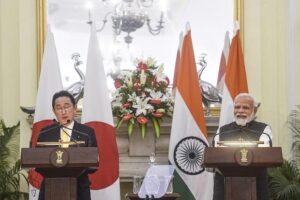

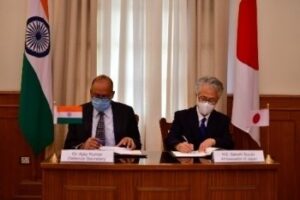

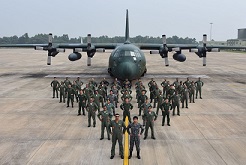



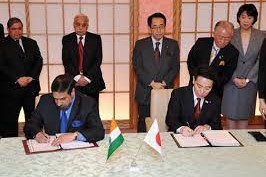

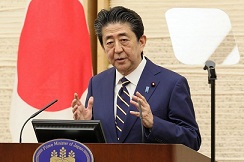
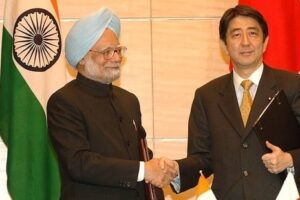

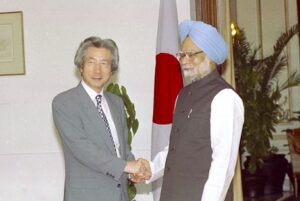
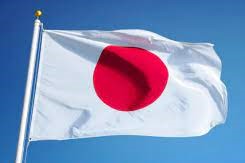
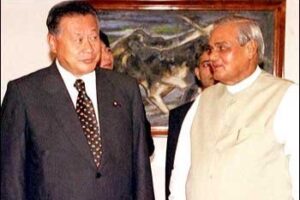
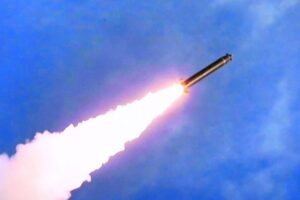




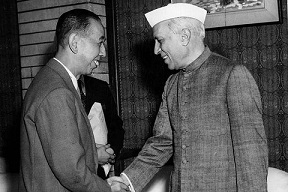










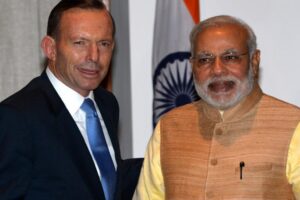





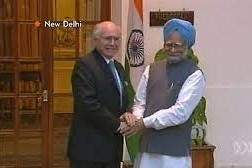
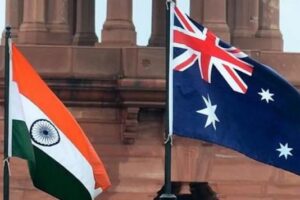


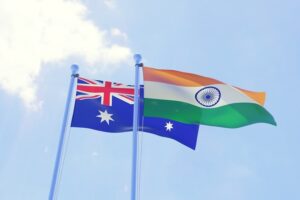

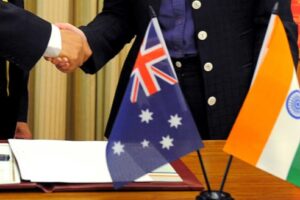

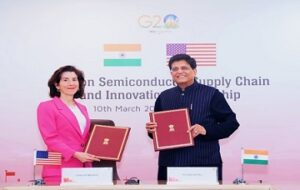
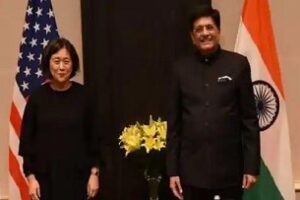
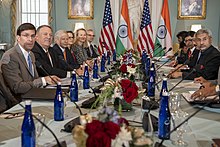

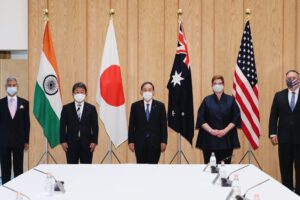

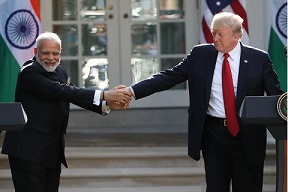
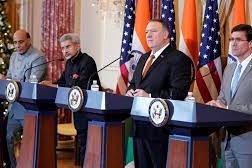

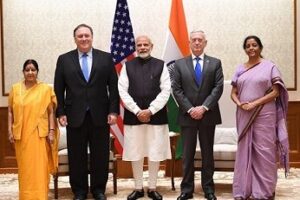

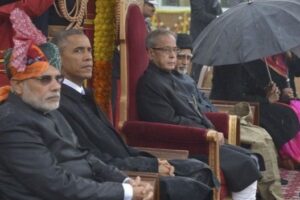

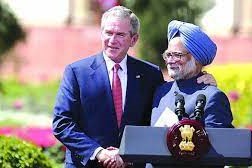
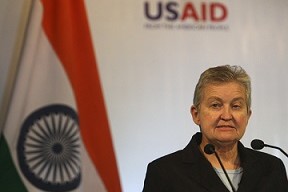
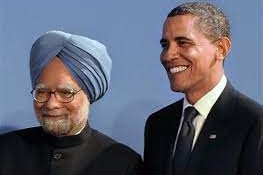


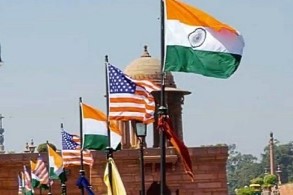
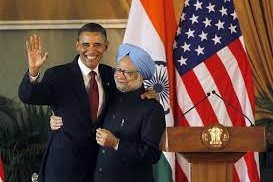


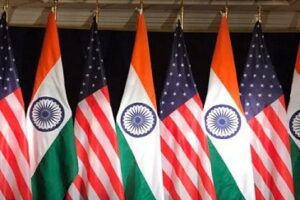
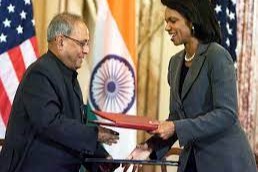




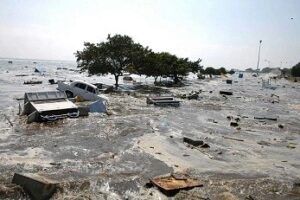

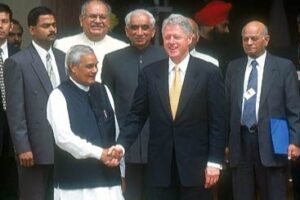
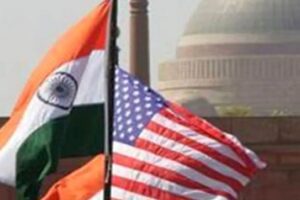
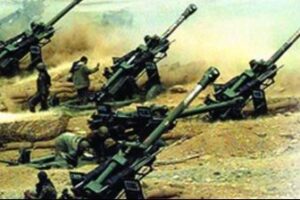
 onducted a total of five underground nuclear tests, breaking a 24-year self-imposed moratorium on nuclear testing. Pakistan followed, claiming 5 tests on May 28, 1998, and an additional test on May 30. The unannounced tests created a global storm of criticism, as well as a serious setback for decades of U.S. nuclear nonproliferation efforts in South Asia. On May 13, 1998, President Clinton imposed economic and military sanctions on India, mandated by Section 102 of the Arms Export Control Act (AECA), and applied the same sanctions to Pakistan on May 30. Some effects of the sanctions on India included: termination of $21 million in FY1998 economic development assistance; postponement of $1.7 billion in lending by the International Financial Institutions (IFI), as supported by the Group of Eight (G-8) leading industrial nations; prohibition on loans or credit from U.S. banks to the government of India; and termination of Foreign Military Sales under the Arms Export Control Act. Humanitarian assistance, food, or other agricultural commodities are excepted from sanctions under the law.
onducted a total of five underground nuclear tests, breaking a 24-year self-imposed moratorium on nuclear testing. Pakistan followed, claiming 5 tests on May 28, 1998, and an additional test on May 30. The unannounced tests created a global storm of criticism, as well as a serious setback for decades of U.S. nuclear nonproliferation efforts in South Asia. On May 13, 1998, President Clinton imposed economic and military sanctions on India, mandated by Section 102 of the Arms Export Control Act (AECA), and applied the same sanctions to Pakistan on May 30. Some effects of the sanctions on India included: termination of $21 million in FY1998 economic development assistance; postponement of $1.7 billion in lending by the International Financial Institutions (IFI), as supported by the Group of Eight (G-8) leading industrial nations; prohibition on loans or credit from U.S. banks to the government of India; and termination of Foreign Military Sales under the Arms Export Control Act. Humanitarian assistance, food, or other agricultural commodities are excepted from sanctions under the law. 




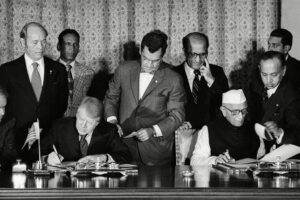
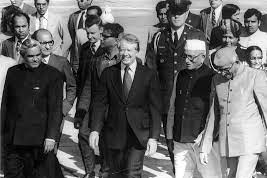

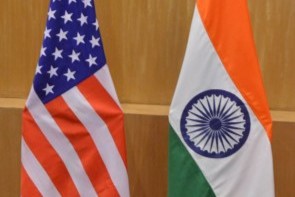



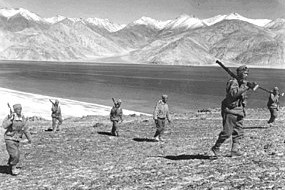



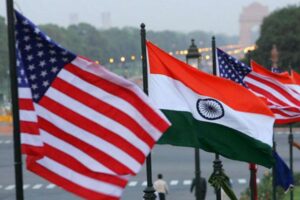
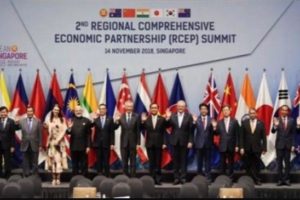 The first ministerial level meeting of QUAD was held on the sidelines of the United Nations General Assembly in New York. Before this, the QUAD had
The first ministerial level meeting of QUAD was held on the sidelines of the United Nations General Assembly in New York. Before this, the QUAD had AusIndEx is an exercise between India and Australia which was first held in 2015.The Australian
AusIndEx is an exercise between India and Australia which was first held in 2015.The Australian 



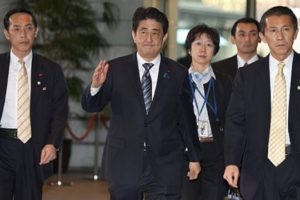



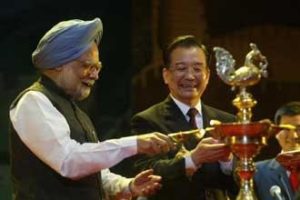 On recommendations of the Japanese government, the four countries met at Manila, Philippines for ASEAN Regional Forum (ARF) originally, but also ended up having a meeting of what we call the first meeting of four nation states on issues of
On recommendations of the Japanese government, the four countries met at Manila, Philippines for ASEAN Regional Forum (ARF) originally, but also ended up having a meeting of what we call the first meeting of four nation states on issues of 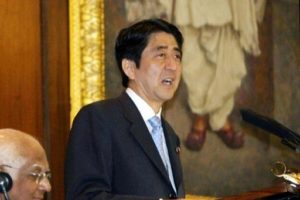 On his official visit to India, Japanese PM Mr. Shinzo Abe reinforced the ties of two nations, i.e., Japan and India with his famous speech about
On his official visit to India, Japanese PM Mr. Shinzo Abe reinforced the ties of two nations, i.e., Japan and India with his famous speech about  In 2007, Japanese President Shinzo Abe resigned from his post citing health reasons. This had a significant impact on QUAD as he was the architect & advocate of QUAD. His successor, Yasuo Fukuda, did not take up QUAD with such zeal leading to dormancy of the forum. (
In 2007, Japanese President Shinzo Abe resigned from his post citing health reasons. This had a significant impact on QUAD as he was the architect & advocate of QUAD. His successor, Yasuo Fukuda, did not take up QUAD with such zeal leading to dormancy of the forum. (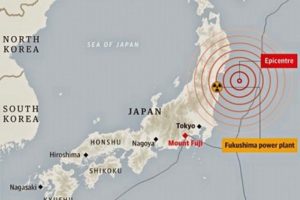 Japan earthquake and tsunami of 2011, also called Great Sendai Earthquake or Great Tōhoku Earthquake, was a 9.0 magnitude earthquake which struck below the floor of the Western Pacific at 2:49 PM. The powerful earthquake affected the northeastern coast of Honshu, Japan’s main island, and also initiated a series of large tsunami waves that devastated coastal areas of Japan, which also led to a major nuclear accident. Japan received aid from India, US, Australia as well as other countries. US Navy aircraft carrier was dispatched to the area and Australia sent search-and-rescue teams.
Japan earthquake and tsunami of 2011, also called Great Sendai Earthquake or Great Tōhoku Earthquake, was a 9.0 magnitude earthquake which struck below the floor of the Western Pacific at 2:49 PM. The powerful earthquake affected the northeastern coast of Honshu, Japan’s main island, and also initiated a series of large tsunami waves that devastated coastal areas of Japan, which also led to a major nuclear accident. Japan received aid from India, US, Australia as well as other countries. US Navy aircraft carrier was dispatched to the area and Australia sent search-and-rescue teams. 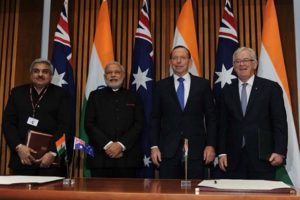 India and Australia signed the
India and Australia signed the  The India-Japan Agreement for Cooperation in the Peaceful Uses of Nuclear Energy was signed on 11 November, 2016 and came into force on 20 July, 2017 which was representative of strengthening ties between India and Japan. Diplomatic notes were exchanged between Dr. S. Jaishankar and H.E. Mr. Kenji Hiramatsu, Ambassador of Japan to India. (
The India-Japan Agreement for Cooperation in the Peaceful Uses of Nuclear Energy was signed on 11 November, 2016 and came into force on 20 July, 2017 which was representative of strengthening ties between India and Japan. Diplomatic notes were exchanged between Dr. S. Jaishankar and H.E. Mr. Kenji Hiramatsu, Ambassador of Japan to India. (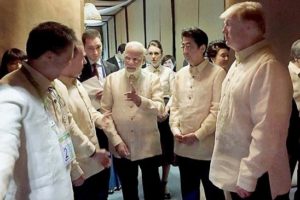 The foreign ministry
The foreign ministry The Officials of QUAD member countries met in Singapore on November 15, 2018 for consultation on regional & global issues of common interest. The main discussion revolved around connectivity, sustainable development, counter-terrorism, maritime and cyber security, with the view to promote peace, stability and prosperity in the
The Officials of QUAD member countries met in Singapore on November 15, 2018 for consultation on regional & global issues of common interest. The main discussion revolved around connectivity, sustainable development, counter-terrorism, maritime and cyber security, with the view to promote peace, stability and prosperity in the  The 23rd edition of trilateral Malabar maritime exercise between India, US and Japan took place on 26 September- 04 October, 2019 off the coast of Japan.
The 23rd edition of trilateral Malabar maritime exercise between India, US and Japan took place on 26 September- 04 October, 2019 off the coast of Japan.  After the first ministerial level meeting of QUAD in September, 2019, the senior officials of US, Japan, India and Australia again met for consultations in Bangkok on the margins of the East Asia Summit. Statements were issued separately by the four countries. Indian Ministry of External Affairs said “In statements issued separately by the four countries, MEA said, “proceeding from the strategic guidance of their Ministers, who met in New York City on the sidelines of the UN General Assembly recently, the officials exchanged views on ongoing and additional practical cooperation in the areas of connectivity and infrastructure development, and security matters, including counterterrorism, cyber and maritime security, with a view to promoting peace, security, stability, prosperity in the Indo-Pacific region.”
After the first ministerial level meeting of QUAD in September, 2019, the senior officials of US, Japan, India and Australia again met for consultations in Bangkok on the margins of the East Asia Summit. Statements were issued separately by the four countries. Indian Ministry of External Affairs said “In statements issued separately by the four countries, MEA said, “proceeding from the strategic guidance of their Ministers, who met in New York City on the sidelines of the UN General Assembly recently, the officials exchanged views on ongoing and additional practical cooperation in the areas of connectivity and infrastructure development, and security matters, including counterterrorism, cyber and maritime security, with a view to promoting peace, security, stability, prosperity in the Indo-Pacific region.” US 2+2 Ministerial Dialogue was held on 18 December, 2019, in Washington DC. Secretary of State Michael R. Pompeo and Secretary of Defense Mark T. Esper will host Indian Minister of External Affairs Dr. S. Jaishankar and Minister of Defense Shri Rajnath Singh. The discussion focussed on deepening bilateral strategic and defense cooperation, exchanging perspectives on global developments, and our shared leadership in the Indo-Pacific region.The two democracies signed the Industrial Security Annex before the 2+2 Dialogue. Assessments of the situation in Afghanistan, Pakistan, Nepal, Sri Lanka, and the Indian Ocean region in general were shared between both countries. (
US 2+2 Ministerial Dialogue was held on 18 December, 2019, in Washington DC. Secretary of State Michael R. Pompeo and Secretary of Defense Mark T. Esper will host Indian Minister of External Affairs Dr. S. Jaishankar and Minister of Defense Shri Rajnath Singh. The discussion focussed on deepening bilateral strategic and defense cooperation, exchanging perspectives on global developments, and our shared leadership in the Indo-Pacific region.The two democracies signed the Industrial Security Annex before the 2+2 Dialogue. Assessments of the situation in Afghanistan, Pakistan, Nepal, Sri Lanka, and the Indian Ocean region in general were shared between both countries. (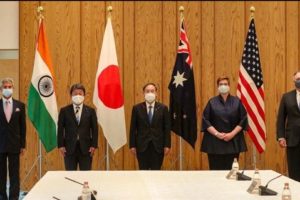 The foreign ministers of QUAD continued their discussions from the last ministerial level meeting in 2019, on 6 October, 2020. While there was no joint statement released, all countries issued individual readouts. As per the issue readout by India, the discussion called for a coordinated response to the challenges including financial problems emanating from the pandemic, best practices to combat Covid-19, increasing the resilience of supply chains, and enhancing access to affordable vaccines, medicines and medical equipment. There was also a focus on maintaining stability in the Indo-Pacific region amidst growing tensions. Australian media release mentions “We emphasised that, especially during a pandemic, it was vital that states work to ease tensions and avoid exacerbating long-standing disputes, work to counter disinformation, and refrain from malicious cyberspace activity. Ministers reiterated that states cannot assert maritime claims that are inconsistent with international law, particularly the United Nations Convention on the Law of the Sea (UNCLOS).”
The foreign ministers of QUAD continued their discussions from the last ministerial level meeting in 2019, on 6 October, 2020. While there was no joint statement released, all countries issued individual readouts. As per the issue readout by India, the discussion called for a coordinated response to the challenges including financial problems emanating from the pandemic, best practices to combat Covid-19, increasing the resilience of supply chains, and enhancing access to affordable vaccines, medicines and medical equipment. There was also a focus on maintaining stability in the Indo-Pacific region amidst growing tensions. Australian media release mentions “We emphasised that, especially during a pandemic, it was vital that states work to ease tensions and avoid exacerbating long-standing disputes, work to counter disinformation, and refrain from malicious cyberspace activity. Ministers reiterated that states cannot assert maritime claims that are inconsistent with international law, particularly the United Nations Convention on the Law of the Sea (UNCLOS).” On September 24, President Biden hosted Prime Minister Scott Morrison of Australia, Prime Minister Narendra Modi of India, and Prime Minister Yoshihide Suga of Japan at the White House for the first-ever in-person Leaders’ Summit of the QUAD. The leaders released a Joint Statement which summarised their dialogue and future course of action. The regional security of the Indo-Pacific and strong confidence in the ASEAN remained on the focus along with response to the Pandemic.
On September 24, President Biden hosted Prime Minister Scott Morrison of Australia, Prime Minister Narendra Modi of India, and Prime Minister Yoshihide Suga of Japan at the White House for the first-ever in-person Leaders’ Summit of the QUAD. The leaders released a Joint Statement which summarised their dialogue and future course of action. The regional security of the Indo-Pacific and strong confidence in the ASEAN remained on the focus along with response to the Pandemic.  The QUAD Vaccine Partnership was announced at the first QUAD Summit on 12 March 2021 where QUAD countries agreed to deliver 1.2 billion vaccine doses globally. The aim was to expand and finance vaccine manufacturing and equipping the Indo-Pacific to build resilience against Covid-19. The launch of a senior-level QUAD Vaccine Experts Group, comprised of top scientists and officials from all QUAD member governments was also spearheaded.
The QUAD Vaccine Partnership was announced at the first QUAD Summit on 12 March 2021 where QUAD countries agreed to deliver 1.2 billion vaccine doses globally. The aim was to expand and finance vaccine manufacturing and equipping the Indo-Pacific to build resilience against Covid-19. The launch of a senior-level QUAD Vaccine Experts Group, comprised of top scientists and officials from all QUAD member governments was also spearheaded.  Although the Tsunami Core group had to be disbanded on fulfilment of its purpose, however the quadrilateral template that formed remained intact as a successful scaffolding of four countries, as stated by authors Patrick Gerard Buchan and Benjamin Rimland in their diplomatic brief about QUAD ( you can access the brief at
Although the Tsunami Core group had to be disbanded on fulfilment of its purpose, however the quadrilateral template that formed remained intact as a successful scaffolding of four countries, as stated by authors Patrick Gerard Buchan and Benjamin Rimland in their diplomatic brief about QUAD ( you can access the brief at 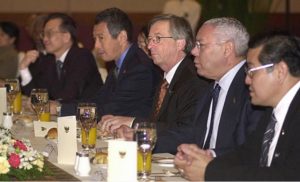 Secretary of State Colin Powell stated that the Core Tsunami Group was to be disbanded and folded and clubbed with the broader United Nations led Relief Operations. In a Tsunami Relief Conference in Jakarta, Secretary Powell stated that
Secretary of State Colin Powell stated that the Core Tsunami Group was to be disbanded and folded and clubbed with the broader United Nations led Relief Operations. In a Tsunami Relief Conference in Jakarta, Secretary Powell stated that 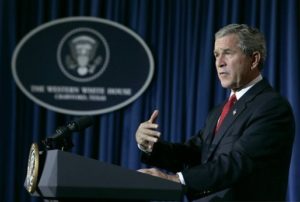 Soon after the Earthquake and Tsunami crisis, humanitarian reliefs by countries, viz., US, India, Japan, and Australia started to help the 13 havoc-stricken countries. The US initially promised $ 35 Millions in aid. However, on 29
Soon after the Earthquake and Tsunami crisis, humanitarian reliefs by countries, viz., US, India, Japan, and Australia started to help the 13 havoc-stricken countries. The US initially promised $ 35 Millions in aid. However, on 29 At 7:59AM local time, an earthquake of 9.1 magnitude (undersea) hit the coast of Sumatra, an Indonesian island. As a result of the same, massive waves of Tsunami triggered by the earthquake wreaked havoc for 7 hours across the Indian Ocean and to the coastal areas as far away as East Africa. The infamous Tsunami killed around 225,000 people, with people reporting the height of waves to be as high as 9 metres, i.e., 30 feet. Indonesia, Srilanka, India, Maldives, Thailand sustained horrendously massive damage, with the death toll exceeding 200,000 in Northern Sumatra’s Ache province alone. A great many people, i.e., around tens of thousands were found dead or missing in Srilanka and India, mostly from Andaman and Nicobar Islands of Indian territory. Maldives, being a low-lying country, also reported casualties in hundreds and more, with several non-Asian tourists reported dead or missing who were vacationing. Lack of food, water, medicines burgeoned the numbers of casualties, with the relief workers finding it difficult to reach the remotest areas where roads were destroyed or civil war raged. Long-term environmental damage ensued too, as both natural and man-made resources got demolished and diminished.
At 7:59AM local time, an earthquake of 9.1 magnitude (undersea) hit the coast of Sumatra, an Indonesian island. As a result of the same, massive waves of Tsunami triggered by the earthquake wreaked havoc for 7 hours across the Indian Ocean and to the coastal areas as far away as East Africa. The infamous Tsunami killed around 225,000 people, with people reporting the height of waves to be as high as 9 metres, i.e., 30 feet. Indonesia, Srilanka, India, Maldives, Thailand sustained horrendously massive damage, with the death toll exceeding 200,000 in Northern Sumatra’s Ache province alone. A great many people, i.e., around tens of thousands were found dead or missing in Srilanka and India, mostly from Andaman and Nicobar Islands of Indian territory. Maldives, being a low-lying country, also reported casualties in hundreds and more, with several non-Asian tourists reported dead or missing who were vacationing. Lack of food, water, medicines burgeoned the numbers of casualties, with the relief workers finding it difficult to reach the remotest areas where roads were destroyed or civil war raged. Long-term environmental damage ensued too, as both natural and man-made resources got demolished and diminished.
No responses yet